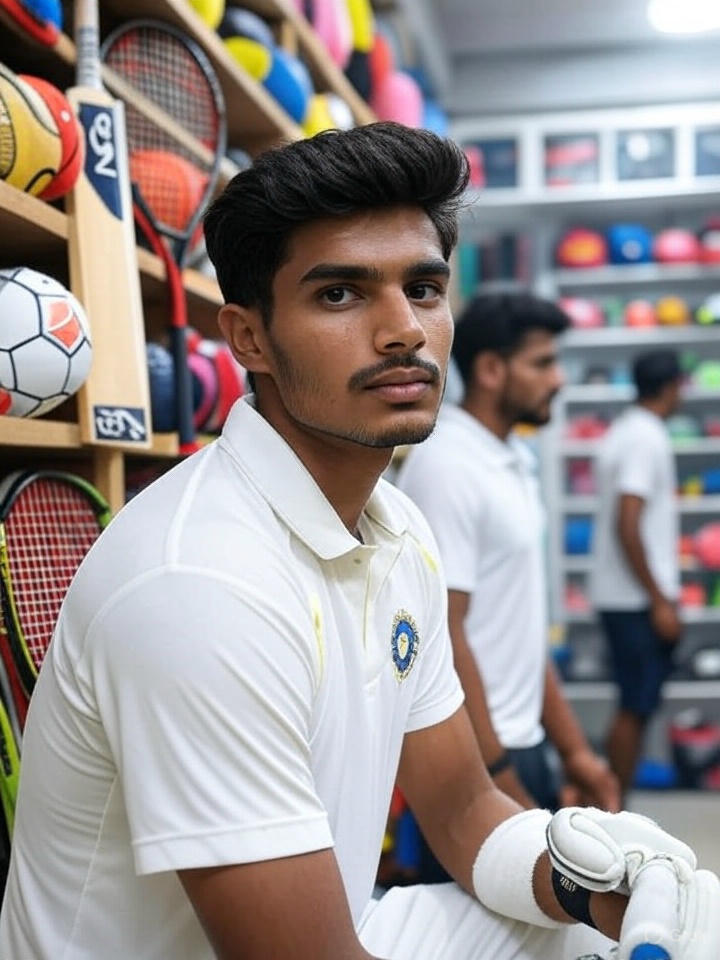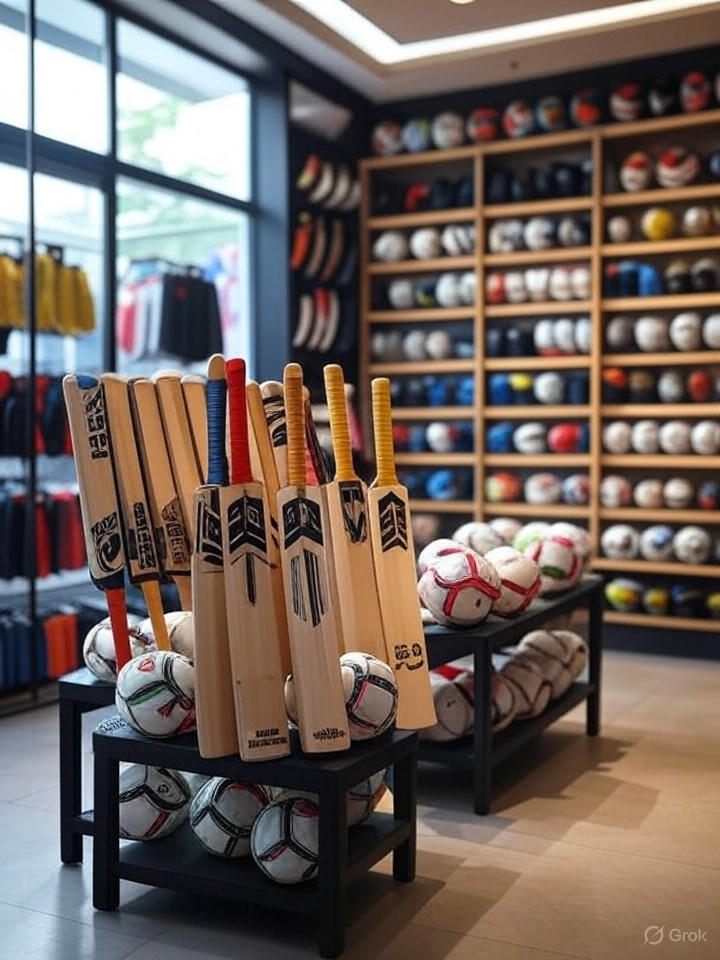India’s sporting spirit is surging. From the enduring passion for cricket to the explosive growth of fitness culture, badminton, football, running, and even niche sports like basketball and table tennis, the Indian sports market is booming. Government initiatives like Khelo India further fuel this enthusiasm, creating fertile ground for entrepreneurs looking to start sports business. Opening a sports shop India offers significant opportunity, but requires meticulous planning and execution. This comprehensive guide outlines every crucial step to transform your sports store startup dream into a profitable reality.
Phase 1: Groundwork & Strategy – Laying the Foundation
- Deep Market Research & Niche Definition:
- Understanding Demand: Analyze your target locality. What sports dominate? Are there schools, colleges, universities, gyms, or sports complexes nearby? What are the prevailing fitness Indian sports trends? Who lives there – families, young professionals, students? This defines your core customer base.
- Competitor Intelligence: Map the landscape. Who are the major players (Decathlon, online giants like Amazon/Flipkart, established local sports equipment shop outlets)? Analyze their strengths, weaknesses, pricing, product range, and customer service gaps.
- Carving Your Niche: Avoid being a “me-too” store. Will you be a generalist or specialize (e.g., premium running gear, comprehensive cricket equipment, budget-friendly fitness essentials, adventure sports, or team supplies)? Identifying a clear niche is one of the most critical sports business ideas for standing out. Precisely define your Target Audience (e.g., serious athletes, school children, casual fitness enthusiasts, institutions).

Crafting a Robust Sports Business Plan India:
- This is your roadmap and essential for securing funding. Include:
- Executive Summary: Your vision, mission, and unique selling proposition (USP).
- Detailed Market Analysis: Findings from your research.
- Products & Services: Specific inventory categories (apparel, footwear, equipment, accessories), brands (international like Nike, Adidas; Indian like SS, Nivia, Cosco), and value-added services (racket stringing, equipment servicing).
- Operations Plan: Store requirements, staffing structure, inventory management system.
- Marketing & Sales Strategy: How you’ll attract customers online and offline.
- Management Structure: Roles and responsibilities.
- Financial Projections: Realistic estimates for sports retail investment (startup costs: rent, renovation, initial inventory, licenses, staffing), operational expenses, sales forecasts, break-even analysis, and funding needs. This section is vital for assessing long-term sports shop profitability.
Navigating Legalities: Sports Shop License India & More:
- Choose a Business Structure: Decide between Sole Proprietorship, Partnership, Limited Liability Partnership (LLP), or Private Limited Company. Consider liability protection and future growth potential.
- Essential Registrations:
- Business PAN Card: Mandatory tax identification.
- Shop & Establishment Act License: Required for any physical retail store, obtained from the local municipal corporation.
- GST Registration: Compulsory for retail sales; choose the appropriate slab.
- Trademark Registration: Protect your brand name and logo. Consider this early.
- Considering a Franchise? Explore sports franchise India options for a potentially faster start with brand recognition, but assess fees, flexibility, and territory restrictions carefully.
- Securing the Perfect Sports Shop Location India:
- Location is paramount for footfall. Prioritize:
- High Visibility & Accessibility: Main roads, near prominent landmarks.
- Target Audience Proximity: Close to schools, colleges, gyms, sports clubs, or residential areas matching your niche.
- Foot Traffic: Areas with consistent pedestrian or vehicular flow (high streets, popular market areas, large shopping malls).
- Parking: Adequate and convenient parking is a major plus.
- Competitor Presence: Being near competitors can be good (destination area) or bad (oversaturation) – analyze carefully.
- Affordability: Balance rental costs with potential revenue. Negotiate terms wisely.
- Store Design & Setup: Create an inviting, functional space. Plan layout (apparel, footwear, equipment zones), invest in durable and attractive fixtures (racks, shelves, display cases), ensure ample lighting and fitting rooms, and incorporate strong branding. First impressions matter.
- Location is paramount for footfall. Prioritize:

Phase 2: Setting Up Operations – Stocking Up & Building Your Team
- Sourcing & Inventory Management: Finding Your Sports Equipment Supplier:
- Supplier Identification: This is critical. Research and contact distributors, wholesalers, and brand representatives. Attend national and regional sports trade fairs. Forge relationships with reliable sports equipment supplier partners. Negotiate margins, credit terms, return policies, and explore potential exclusivity deals.
- Building Initial Stock: Focus on your niche and target audience. Stock core, high-demand items initially. Avoid overstocking; start lean and scale based on sales data. Balance popular international brands with quality, often more affordable, Start sports brand India options.
- Inventory Control: Implement a robust system immediately – dedicated software is highly recommended over manual methods. Track stock levels meticulously, monitor sales velocity, set reorder points (EOQ), and minimize dead stock to protect sports shop profitability.
- Strategic Pricing:
- Cost-Plus Pricing: Cover Cost of Goods Sold (COGS), overheads, and desired profit margin.
- Competitive Pricing: Benchmark key items against local competitors and major online players (Sports gear online India).
- Value-Based Pricing: Price higher for unique products, premium positioning, or exceptional service.
- Psychological Pricing: Utilize tactics like Rs. 1,999 instead of Rs. 2,000.
- Plan for Promotions: Factor in seasonal sales, clearance discounts, and loyalty program offers.
- Hiring & Training Champions:
- Recruitment: Look beyond retail experience. Prioritize candidates with genuine passion for sports, excellent communication skills, and a customer-centric attitude. Basic product knowledge is a plus.
- Comprehensive Training: Invest heavily in training. Staff must become product experts – understanding features, benefits, sizing, brand differences, and even basic sport-specific knowledge (e.g., tennis racket tensions, running shoe pronation). Train on POS systems, store policies, returns handling, and exceptional customer service. Knowledgeable staff build trust and drive sales.
Phase 3: Launch & Marketing – Making Your Debut
- Generating Pre-Launch Buzz:
- Build Online Presence: Create active profiles on Instagram and Facebook – crucial platforms for Sports shop marketing.
- Local Outreach: Contact local newspapers, community websites, and radio stations. Put up posters in community centers, gyms, and clubs.
- Teasers & Contests: Run social media contests (“Guess the opening date, win a voucher”) and teaser posts about your unique offerings.
- Soft Launch: Invite local sports influencers, club representatives, and neighbors for a preview and feedback session. Offer light refreshments.
- The Grand Opening:
- Attractive Offers: Drive initial traffic with compelling launch discounts or “buy one get one” deals on select items.
- Experience & Events: Host in-store events: athlete meet-and-greets, product demonstrations (e.g., shoe fitting tech), free workshops (basic fitness, equipment maintenance).
- Atmosphere: Create a festive vibe with music, refreshments, and perhaps branded giveaways.
- Leverage Influencers: Partner with local sports personalities or fitness micro-influencers for promotion.

- Sustained Sports Shop Marketing:
- Digital Dominance:
- SEO & Google My Business: Optimize your GMB profile and website (even a basic one) for local searches (“sports shop near me,” “cricket bats in [City]”).
- Targeted Social Ads: Run ads on Instagram/Facebook targeting local sports and fitness enthusiasts.
- Email & WhatsApp Marketing: Build a subscriber list for newsletters, exclusive offers, and new arrival updates.
- Hyper-Local Engagement:
- Partnerships: Collaborate with local gyms, sports clubs, schools, and coaches. Offer affiliate programs or sponsor local tournaments.
- Community Events: Participate in or sponsor local marathons, tournaments, or fitness camps.
- Flyers & Local Media: Don’t underestimate targeted physical flyers in relevant locations.
- Loyalty Programs: Implement a program rewarding repeat customers (points, tiered discounts, early access to sales) – crucial for retention.
- In-Store Promotions: Regularly run seasonal sales, bundle offers (racket + shoes + bag), and clearance events.
- Digital Dominance:
Phase 4: Running & Growing – Building a Legacy
- Uncompromising Customer Experience:
- Knowledgeable & Friendly Staff: This remains paramount. Empower staff to solve problems and delight customers.
- Hassle-Free Policies: Offer a clear, fair, and well-communicated return/exchange policy.
- Store Ambiance: Maintain a clean, well-organized, and inviting store environment.
- Personalization: Remember customer preferences, offer tailored advice, build relationships. This is where independent stores can outshine chains and online.
- Financial Discipline:
- Meticulous Bookkeeping: Use accounting software. Track every rupee in and out.
- Regular Reviews: Analyze Profit & Loss statements and cash flow weekly/monthly. Monitor sports shop profitability closely.
- Cost Control: Negotiate with suppliers, optimize staffing, manage utilities efficiently.
- Compliance: Ensure timely GST filing and tax payments.
- Embracing Omnichannel: Sports Gear Online India is Essential:
- Beyond the Physical Store: To compete, you must have an online presence:
- Website: Showcase products, store info, and contact details. Eventually, add e-commerce functionality to start sports shop online.
- Marketplaces: List products on Flipkart, Amazon, Meesho to reach a vast audience. Understand their fees and logistics requirements.
- Social Commerce: Utilize Instagram Shopping and Facebook Shops features.
- Click & Collect: Allow customers to buy online and pick up in-store (BOPIS).
- Inventory Synchronization: Ensure real-time stock updates across all channels to avoid overselling. This is a key operational challenge.
- Beyond the Physical Store: To compete, you must have an online presence:
- Adaptation, Innovation & Growth:
- Listen & Learn: Actively seek customer feedback through surveys, reviews, and direct conversations. Adapt accordingly.
- Track Trends: Stay abreast of evolving Indian sports trends, fitness crazes, and retail innovations.
- Data-Driven Decisions: Analyze sales data to identify bestsellers, slow-movers, customer preferences, and optimize buying.
- Expand Offerings: Gradually introduce new product lines or services based on demand (e.g., nutritional supplements, specialized fitness equipment, repair services).
- Scaling Up: Explore opening a second location, expanding your current store, or significantly boosting your online operations (Sports gear online India).
Conclusion: Your Winning Playbook
Launching a successful sports shop India is an exciting yet demanding venture. Sports retail investment requires careful planning, strategic execution, and unwavering customer focus. Success hinges on thorough sports business plan India development, securing the right sports shop location India, building strong relationships with your sports equipment supplier, mastering sports shop marketing, and embracing both offline and online (Sports gear online India) channels.
By understanding the Indian sports market, identifying a clear niche, prioritizing exceptional customer experience, maintaining financial discipline, and staying agile to Indian sports trends, you can build a profitable and respected sports equipment shop. The market potential is vast, fueled by a nation increasingly passionate about sports and fitness. With dedication, the right strategy, and a genuine love for the game, your sports store startup can truly score big. Now, step onto the entrepreneurial field and play to win!
Brewing Success Series –




